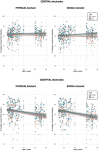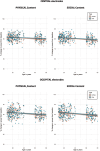Neural empathy mechanisms are shared for physical and social pain, and increase from adolescence to older adulthood
- PMID: 39492751
- PMCID: PMC11630255
- DOI: 10.1093/scan/nsae080
Neural empathy mechanisms are shared for physical and social pain, and increase from adolescence to older adulthood
Abstract
Empathy is a critical component of social interaction that enables individuals to understand and share the emotions of others. We report a preregistered experiment in which 240 participants, including adolescents, young adults, and older adults, viewed images depicting hands and feet in physically or socially painful situations (versus nonpainful). Empathy was measured using imagined pain ratings and EEG mu suppression. Imagined pain was greater for physical versus social pain, with young adults showing particular sensitivity to social pain events compared to adolescents and older adults. Mu desynchronization was greater to pain versus no-pain situations, but the physical/social context did not modulate pain responses. Brain responses to painful situations increased linearly from adolescence to young and older adulthood. These findings highlight shared activity across the core empathy network for both physical and social pain contexts, and an empathic response that develops over the lifespan with accumulating social experience.
Keywords: EEG; aging; empathy; physical and social pain; sensorimotor mirror system.
© The Author(s) 2024. Published by Oxford University Press.
Conflict of interest statement
None declared.
Figures





Similar articles
-
The impact of mood on empathy for pain: Evidence from an EEG study.Psychophysiology. 2017 Sep;54(9):1311-1322. doi: 10.1111/psyp.12882. Epub 2017 Apr 27. Psychophysiology. 2017. PMID: 28449372
-
Somatosensory mu activity reflects imagined pain intensity of others.Psychophysiology. 2015 Dec;52(12):1551-8. doi: 10.1111/psyp.12522. Epub 2015 Sep 7. Psychophysiology. 2015. PMID: 26379210
-
Childhood emotional invalidation and right hemispheric mu suppression during a pain empathy task: An EEG study.Soc Neurosci. 2019 Apr;14(2):236-250. doi: 10.1080/17470919.2018.1441905. Epub 2018 Mar 4. Soc Neurosci. 2019. PMID: 29451071
-
Neural circuits and therapeutic mechanisms of empathic pain.Neuropharmacology. 2025 Mar 1;265:110268. doi: 10.1016/j.neuropharm.2024.110268. Epub 2024 Dec 12. Neuropharmacology. 2025. PMID: 39674400 Review.
-
Behavioral manifestations and neural mechanisms of empathic pain.Neuropharmacology. 2025 May 15;269:110344. doi: 10.1016/j.neuropharm.2025.110344. Epub 2025 Feb 6. Neuropharmacology. 2025. PMID: 39922532 Review.
Cited by
-
Can ketamine and other glutamate receptor modulators be considered entactogens?Psychiatry Res. 2025 Jul;349:116513. doi: 10.1016/j.psychres.2025.116513. Epub 2025 Apr 25. Psychiatry Res. 2025. PMID: 40328099
-
Classifying social and physical pain from multimodal physiological signals using machine learning.Sci Rep. 2025 Jul 29;15(1):27674. doi: 10.1038/s41598-025-12476-8. Sci Rep. 2025. PMID: 40731063 Free PMC article.
References
Publication types
MeSH terms
Grants and funding
LinkOut - more resources
Full Text Sources
Other Literature Sources
Medical
Research Materials

